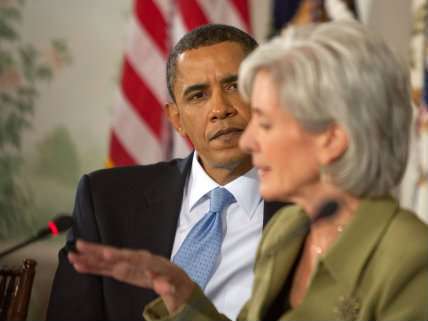Insurers Testify that 10-20 Percent of Obamacare Sign-Ups Haven't Paid, Some Are Duplicates

Since last fall, when Obamacare's exchanges opened for business, the Obama administration has been releasing enrollment reports that don't actually count enrollments. Instead, they count sign-ups—the number of people who have "selected a plan" through the law's health insurance exchanges. Those people may or may not have paid their first month's premium. If they haven't, and don't, then they are never enrolled.
So how many aren't paying up? Since January, multiple reports based on insurance industry sources have warned that roughly one in five, or twenty percent, of people who sign up for plans are not following through with payment. Health and Human Services Secretary Kathleen Sebelius has said that somewhere in the range of 80 to 90 percent of sign-ups resulted in an activating payment, but the Obama administration has not yet provided any official figures. When asked about payment rates, officials have suggested that the information was in the hands of insurers, and that interested parties should direct inquiries toward them.
That's exactly what Republicans on the House Energy & Commerce Committee did. In April, the committee surveyed all of the insurers participating in the federal exchange, which covers 36 states, and last week released a report saying that just 67 percent of sign-ups had paid for the first month.
As I noted at the time, there were some problems with the report. It ignored some of the bigger states that are running their own exchanges, like California and New York, and, more importantly, it reported a payment figure that was current as of April 15—despite the fact that a big chunk of the sign-ups were not required to pay until the first week of May, when their coverage went into effect. Some of those people hadn't paid, but they hadn't blown a deadline either.
Today, the Energy & Commerce Committee is holding a hearing following up on the non-payment issue featuring testimony from health insurers. And, based on early testimony and news reports, most of what insurers will say is essentially what we already know: that last week's Energy & Commerce report wasn't a reliable guide to how many people will end up paying, and that the actual non-payment rate is somewhere between 80 and 90 percent, depending on the plan and the region.
As many as 90 percent of WellPoint customers have paid their first premium by its due date, according to testimony the company prepared for a congressional hearing today. For Aetna, the payment is in the "low to mid-80 percent range," the company said in its own testimony. Health Care Service Corp., which operates Blue Cross Blue Shield plans in five states including Texas, said that number is at least 83 percent.
That's two insurers who peg their payment rates in the low 80s, and another that says it's as much as 90 percent in some places, which means that in total it's somewhat less than 90 percent. This means that the payment rate, overall, is likely somewhere in the mid 80s, which more or less matches what Karen Ignani, the head of America's Health Insurance Plans (AHIP), the major insurance industry trade group, has already said. It also fits with the 85-percent paid estimate we've heard from officials in California.
Liberals are already crowing about the industry because it proves the GOP report wrong. The House GOP botched this one, I think, but today's testimonies leave us mostly back where we started, with a rather significant downward correction on the way.
A fifteen percent reduction from the 8 million sign-ups the administration reports means cutting total enrollment by 1.2 million people, dropping actual enrollment to about 6.8 million. That's pretty close to the Congressional Budget Office's (CBO) original projection of 7 million exchange sign-ups, and it's higher than the CBO's revised projection of 6 million sign-ups, but it's not a small cut. Even if the reduction is somewhat smaller—say, 12 percent, that's still nearly a million enrollments chopped off the administration's sign-up total.
And, of course, it's also still possible that the reduction is somewhat larger, say 15 or 20 percent. The New York Times report on today's testimony still puts total payments at around 80 percent in its opening paragraph, which would mean an even bigger drop.
The Times report also flags an item from AHIP's prepared testimony noting "many duplicate enrollments" in the system. Because of the botched launch of the exchanges, some shoppers ended up enrolling twice. "As a result," the AHIP testimony says, "insurers have many duplicate enrollments in their system for which they never received any payment. In cases where an insurer has a new enrollment for a consumer who previously enrolled, they are not expecting that original policy to be effectuated—even though that data is still reported."
How big a problem will the duplicates turn out to be? AHIP doesn't offer any guesses. It's possible that it won't be a major issue at all; last fall, when the federal exchange system was essentially unusable, we heard about Obamacare "orphans" stuck in the system. This turned out to be a real problem, but not on a massive scale. About 13,000 people were affected. On the other hand, the issue is big enough that AHIP felt it necessary to mention in hot-button congressional testimony.
So here's where we're at on the sign-up issue: The House GOP report was too early, ignored deadline issues, and turned out to be problematic as a result. But based on insurer testimony, the administration's much-touted total of 8 million sign-ups is likely to be reduced by a million or more when converted into paid enrollments. In other words, the administration's figures were too rosy by quite a bit—just not as much as House Republicans suggested.


Show Comments (59)